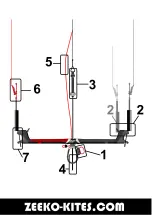
English Version
Introduction
You must read and understand the entire contents of this manual before any attempt to fly your kite. The manual
has been written to help you operate your new kite, but nothing replaces proper instruction.
You must be fully aware of the risks that go with this sport, and know that you are exposing yourself to real danger.
Inappropriate use of traction kite devices can result in (serious) accidents or even lead to the death of the user or
third parties. It is strongly recommended to undergo an initial training in a recognized kitesurf school.
As defined by this user manual, the distributors of our products are under no circumstances liable for material or
bodily damage sustained as a result of inappropriate use of this product.
Essential rules
• Never forget that you are responsible for any material or bodily damage sustained while using this product. Check
that you are appropriately insured against possible damages resulting from the sport of kitesurfing.
• Use your common sense at all times.
• NEVER kitesurf ALONE. An assistant is a considerable safety asset, on land as well as at sea.
• NEVER attach yourself permanently to your kite by any means (e.g. tying the lines onto your harness).
It is imperative that you are able to disconnect yourself from the kite quickly if you are experiencing difficulties.
• You must not dismantle or modify the quick releases built into your control bar.
• Respect local regulations pertaining specifically to this sport.
• Kitesurfing is an exhausting sport, especially for beginners who will tire more quickly. Learn to recognize the early
signs
of fatigue and come in to rest.
• It is essential to know how to swim.
• You must be fully comfortable with procedures for launching, landing, and returning to the beach in case of
difficulties.
• Never operate your kite while you are attached to a fixed object such as a car or a tree.
• This kite is designed specifically to be used as a traction device for kitesurfing, and must never be used for
paragliding or any other forms of unassisted flight. Never jump on the beach.
• Never touch the bridles or flying lines while they are under tension.
• If your kite is not in use but is inflated, it must be secured in the neutral position using sand or heavy objects. It
must be secured and the control bar disconnected from the kite.
• Never lend a kite to anyone who is unfamiliar with the power developed by serious traction devices.
• For your safety and that of others around you, never accept assistance from a person who might not be competent
in landing or launching procedures.
• Check and try the quick release before each ride.
Safety
Operating space
On the ground
• You must check that your chosen operating space is free of any obstacles, people or animals. To manoeuvre your
kite, you need AT LEAST 100 METERS DISTANCE on either side of your kite, as well as DOWNWIND (the area in
front of you when your kite is air-borne). Be especially careful of obstacles downwind of you.
• Before launching, be sure to have identified a safe landing area further downwind, in the event you are not able to
return to your departure point.
• Never use your kite near people, animals, posts, trees, buildings, cars, power lines, airports, roads, etc…
On the water
• Your operating space must be completely free of boats, buoys, rocks, pontoons, piers, jetties, etc… Stay as far
away as possible from swimmers, and don’t sail in shipping lanes. Respect no-fly/ride zones.
• Avoid vertical areas bounded by rocks or cliffs where the wind might be extremely turbulent.
Weather
• Never underestimate the wind and sea conditions.
• Consult the local forecast before setting out.
* Never attempt to kitesurf in changing or stormy weather conditions.
* Never attempt to kitesurf if the wind is strong and gusty.
* Never attempt to kitesurf if the wind is off shore, blowing you away from land.
* Never ride in or near electrical storms as the flying lines will massively increase your risk of electrocution.
• Find out about tides and areas with strong currents.
• Beginners must sail in calm sea conditions.
• Take time to gauge the wind speed once you have reached your chosen sailing area.
• If you are not confident in evaluating the forecast, speak to someone who is competent in forecast interpretation.
• Wear suitable equipment to avoid hypothermia-related accidents (wetsuits and drysuits).
* Safety helmets and impact vests are strongly recommended.
Summary of Contents for Notus
Page 5: ...How to release and reload the quick release...
Page 6: ...How to connect the safety leash for the bar...
Page 8: ......
Page 15: ...Comment connecter votre leash votre barre...
Page 17: ......
Page 20: ......

















